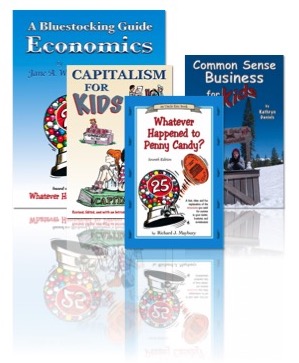
Business, Economics and Entrepreneurship Course for Middle School Students
Where to Buy

Reading Level
These books have been used by students ages 10 and up, but are best suited for most students ages 12-14 and up.

Course Uses
Provides an excellent introduction to economics, business, as well as the philosophy of entrepreneurship.

Study Time Frame
This course should be able to be completed in a single semester. See below for details.
ABOUT THE COURSE
The books included in the “Business, Economics & Entrepreneurship Course for Middle School Students” curriculum provide an excellent introduction to economics, business, as well as the philosophy of entrepreneurship. But you don’t have to take our word for it!
“I have been searching for an economics course that would be suitable for middle school students. Much to my pleasure, I found exactly what I was looking for in Business, Economics and Entrepreneurship for Middle School Students by Bluestocking Press!
Whatever Happened to Penny Candy? was recommended to me over and over, which was what originally led me to the Bluestocking Press site. I was overjoyed to find an entire curriculum set for middle school students that included not only the book I was looking for, but three others!
Whatever Happened to Penny Candy? is a simply written book of 15 chapters that helps students (and adults like me) understand the basics of the economics system in the United States. Not only that, but it incorporates history and current events in as well.
In real terms that aren’t weighty and hard-to-grasp, your children will finish this book with more information than I was ever taught (even in college) about such things as wages, inflation, recessions, federal debt, and so much more. Even better, there’s a common-sense sort of humor to the book that kept me chuckling all the way through.
Bluestocking Guide: Economics is a sort of workbook/test book/extra study guide to go along with Whatever Happened to Penny Candy. It includes extra articles to further study and understanding of each chapter in the “primer” (which is Whatever Happened to Penny Candy), as well as discussion questions and tests. The tests include everything from short answers and definitions to multiple choice and essay questions. Further reading lists, charts and diagrams are included, too.
You could read the primer without using this book, but it really helps round out the course.
Common Sense Business for Kids is 17 chapters, but only 62 pages of just what it says – common sense. Students learn the ins and outs of what it takes to successfully run a business – things like operating costs, markets, needs vs. wants, changing with the times, keeping inventory, employees and salesmanship.
Since each chapter is only a few pages, the info is not in depth, but instead very to-the-point. I find that extremely refreshing, and I have a feeling your kids will, too!
Capitalism for Kids is subtitled Growing Up to Be Your Own Boss. With a little more depth and a different range of topics, this book continues on the same theme as Common Sense Business for Kids.
Chapters focus on such topics as evaluating what sort of business best suits the child’s interests and talents, capitalism vs. communism and socialism, family businesses, investing time and money, gaining education and experience, and even such things as laws and licenses.
Again, I really like the common sense writing that isn’t too wordy or philosophical. Quite simply it’s written to kids for them to read themselves.
Even though this curriculum is suggested for middle school, I found it to be meaty enough for many high school students. However, if you’re hoping to find a set put together specifically for high school, Bluestocking Press offers two.
1. Economics Course for High School Students
2. Economics and Nature of Government for High School Students
Both contain some of the same books that are in the middle school kit, so you will want to decide which age level you’d most like to purchase and then purchase only that set. On the other hand, all of the books contained in the sets are available individually for those who would prefer to simply go through one or two books.Loving this!”
–Cindy West, The Curriculum Choice, http://thecurriculumchoice.com
ABOUT THE UNCLE ERIC BOOKS
The Uncle Eric books, written by Richard J. Maybury, are written for young and old alike.
Using the epistolary style of writing (using letters to tell a story), Mr. Maybury plays the part of an economist writing a series of letters to his niece or nephew.
With stories and examples, he gives interesting and clear explanations of topics that are generally thought to be too difficult for anyone but experts.
ABOUT THE BLUESTOCKING GUIDES
Bluestocking Guides are designed to reinforce and enhance a student’s understanding of the subject matter presented in the primer. Comprehension Questions are given for each chapter – these include:
•Definition
•True/False
•Short Answer/Fill-in questions
Answers are located in the back of the study guide.
Application Exercises are also provided, depending on the chapter and the topic covered therein. Generally, Application Exercises ask the student to apply the knowledge learned from the corresponding chapter to “real world” situations so that the student may personalize the information and better retain and apply the knowledge gained from the primer. Application Exercises are typically comprised of one of the following types:
•Discussion
•Essay
•Research assignment
Suggestions for further study (books, movies, etc.) are included in many of the guides.
In addition to assisting the student in the retention of the subject matter, the study guides will serve as documentation of course completion.
WHAT’S INCLUDED
- Whatever Happened to Penny Candy?
- A Bluestocking Guide: Economics
- Capitalism for Kids
- Common Sense Business for Kids
TIME FRAME FOR STUDY
Bluestocking Press’ publications were designed with flexibility in mind so that they could be used in a variety of educational settings. That said, we typically suggest completing this course in one semester and with the following order of reading:
Start with A Bluestocking Guide: Economics.
About 1/4 of the way through A Bluestocking Guide: Economics, students will be instructed to begin reading Whatever Happened to Penny Candy? as well.
Once the above two books are completed, students can move on to Capitalism for Kids, and finish the course with Common Sense Business for Kids.
